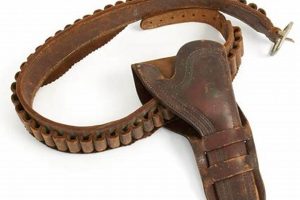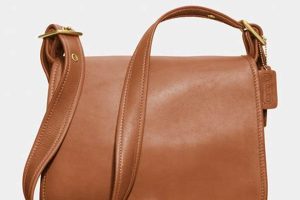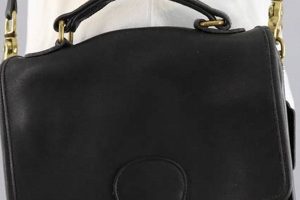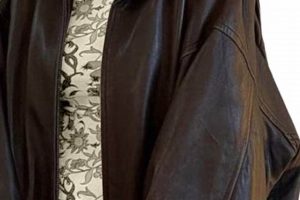An article of outerwear crafted from tanned animal hide, typically bovine, and predating recent manufacturing, represents a significant element of sartorial history. These garments, often distinguished by unique design features, construction techniques, and material qualities characteristic of previous eras, offer a tangible connection to past aesthetics and manufacturing processes. For example, a World War II-era aviator jacket or a 1970s biker jacket exemplify specific historical periods and styles.
Such items hold considerable value beyond mere functionality. Their appeal stems from their durability, the patina acquired through age and use, and their embodiment of historical narratives. They offer wearers a distinctive style, often conveying a sense of individuality and appreciation for craftsmanship. The garment’s history, potentially linked to specific events or individuals, adds to its perceived worth and collectibility. Furthermore, acquiring such a piece often represents a sustainable fashion choice, promoting the reuse of existing materials and reducing demand for newly manufactured goods.
The subsequent sections will delve into the specific characteristics that define these garments, explore their care and preservation, and discuss factors influencing their valuation and desirability in the collector’s market. Understanding these aspects allows for informed appreciation and responsible ownership.
Essential Considerations for Acquiring a Vintage Leather Coat
The purchase of pre-owned leather outerwear requires careful assessment to ensure both authenticity and long-term satisfaction. The following considerations are crucial for making an informed decision.
Tip 1: Assess the Leather Quality: Examine the hide for signs of excessive wear, dryness, or cracking. Supple, well-preserved leather indicates quality and proper care. Brittle or heavily damaged leather may indicate neglect or irreversible deterioration.
Tip 2: Verify Authenticity of Markings: Examine interior labels and manufacturer stamps for consistency with the purported era of production. Research known trademarks and design features of the claimed manufacturer to identify potential inconsistencies.
Tip 3: Scrutinize the Stitching and Hardware: Inspect seams for loose or broken stitches, which may indicate weakness in the garment’s structure. Evaluate the condition of zippers, buttons, and other hardware; ensure they are original to the garment and in functional order. Replacement hardware can diminish value and authenticity.
Tip 4: Evaluate the Lining and Interior: Examine the lining for tears, stains, or odors. A damaged or poorly maintained lining may require costly repairs. The condition of the interior reflects the overall care given to the garment.
Tip 5: Consider the Fit and Style: Assess whether the garment’s cut and proportions align with contemporary fashion sensibilities. Modifications or alterations may be necessary to achieve a desired fit. A well-fitting garment will enhance its wearability and overall value.
Tip 6: Inspect for Odors: Leather can absorb odors over time. Inspect the coat for musty, smoky, or other unpleasant smells that may be difficult to remove.
Tip 7: Understand the Storage Conditions: Inquire about the previous storage conditions. Excessive humidity, sunlight, or improper hanging can damage leather over time.
Adhering to these guidelines ensures a more informed purchase, minimizing the risk of acquiring a misrepresented or structurally unsound garment. Careful evaluation protects the investment and enhances the potential for long-term enjoyment.
The subsequent discussion will focus on the proper maintenance and preservation of these unique articles of clothing, ensuring their longevity and continued appeal.
1. Material Integrity
Material integrity constitutes a foundational element in assessing and preserving a vintage leather coat. The original composition and subsequent preservation of the leather directly dictate the garment’s longevity, aesthetic appeal, and historical value. Degradation of the leather, often manifested as cracking, dryness, or excessive wear, fundamentally compromises the integrity of the piece. This degradation may stem from environmental factors such as prolonged exposure to sunlight or humidity, improper storage practices, or the inherent limitations of tanning processes employed during the garment’s original manufacture.
The consequences of compromised material integrity extend beyond mere cosmetic flaws. Structural weaknesses, such as weakened seams or tears in the hide, can render the coat unwearable or necessitate costly repairs. The patina, a naturally occurring surface alteration that often enhances the character of aged leather, can be irreparably damaged by improper cleaning or treatment. A prime example is a vintage military flight jacket with severely cracked and stiffened leather, indicating a lack of proper conditioning. Such a garment, while potentially retaining historical significance, suffers a significant reduction in its practical usability and market value. Understanding the factors that contribute to material degradation enables proactive measures for preservation, ensuring the continued integrity of these historical artifacts.
In conclusion, the material integrity of vintage leather outerwear directly impacts its value, usability, and historical significance. Recognizing the signs of degradation and implementing appropriate preservation techniques are critical for safeguarding these garments for future generations. Addressing existing damage and preventing further deterioration through informed care practices represents a vital component in the responsible stewardship of these tangible links to the past.
2. Era Authenticity
Era authenticity, when considered in relation to pre-owned leather outerwear, denotes the verifiable and accurate representation of a garment’s origin within a specific historical period. This characteristic is paramount, as it directly influences the item’s value, collectibility, and its significance as a historical artifact. A lack of demonstrable era authenticity reduces an alleged vintage piece to merely a replica or a reproduction, devoid of the genuine historical context that collectors and enthusiasts seek. Establishing authenticity necessitates meticulous examination of design elements, manufacturing techniques, materials used, and any identifiable markings or labels, cross-referenced against established historical records and manufacturing practices. For instance, a claim that a leather motorcycle jacket originated in the 1950s must be substantiated by features such as a specific type of lining material, the use of particular hardware types (zippers, snaps), and a style consistent with documented fashion trends of that era. Inconsistencies in these elements cast doubt on the claim of authenticity.
The importance of era authenticity stems from the fact that genuine vintage garments offer a tangible connection to the past. They represent the design aesthetics, cultural values, and technological capabilities of a specific period. Furthermore, a garment’s authenticity influences its potential for preservation and restoration. Knowledge of the original materials and construction techniques is essential for implementing appropriate conservation measures. For example, attempting to clean a pre-1940s leather coat with modern solvents could irreparably damage the leather due to differing tanning processes used at the time. Conversely, an understanding of the era-specific methods allows for informed and respectful restoration efforts. Consider a “bomber jacket” purportedly from WWII. Verification hinges on details like the type of leather used, the construction of the lining (wool vs. synthetic), and the presence of specific government-issued markings.
In conclusion, era authenticity is a critical determinant of value and historical relevance of older leather outwear. It requires meticulous verification against established historical and manufacturing records. While challenges exist in definitively proving the origin of every piece, a rigorous approach to authentication ensures that genuine historical artifacts are properly identified, valued, and preserved, preventing misrepresentation and safeguarding the historical integrity of these garments. The ability to discern genuine articles from reproductions or later iterations enhances the appreciation and stewardship of these tangible links to the past.
3. Construction Quality
Construction quality, as it pertains to pre-owned leather outerwear, serves as a crucial indicator of the garment’s durability, longevity, and overall value. The methods and materials employed in the original manufacturing process directly influence the garment’s ability to withstand wear and tear, resist environmental damage, and retain its structural integrity over time. Therefore, careful assessment of construction quality is paramount when evaluating such garments.
- Seam Integrity and Stitch Density
The robustness of the seams, indicated by stitch density and the type of stitching used (e.g., double stitching, chain stitching), directly impacts the garment’s resistance to stress and potential for seam failure. A garment with tightly spaced, reinforced seams is less prone to unraveling or tearing under strain. For example, a military-issued flight jacket from the mid-20th century would typically feature high stitch density and reinforced seams in areas subject to significant stress, such as the shoulders, elbows, and armholes. Conversely, a garment with loosely spaced or poorly secured seams will exhibit a greater risk of structural degradation.
- Leather Panel Assembly and Grain Matching
The manner in which leather panels are joined together, and the degree to which the grain patterns are matched, contribute to both the aesthetic appeal and structural integrity of the garment. High-quality construction involves careful selection and matching of leather panels to ensure a uniform appearance and consistent resistance to stretching or distortion. Poorly matched panels can result in uneven wear patterns and a visually disjointed appearance. A well-crafted example demonstrates consistent grain direction and minimal visible seams, creating a cohesive and durable surface.
- Lining Attachment and Reinforcement
The method of attaching the lining to the leather shell, and the presence of reinforcements in high-wear areas, significantly impact the garment’s comfort, durability, and overall lifespan. A properly attached lining should be securely stitched or bonded to the leather, with reinforced areas around the cuffs, collar, and hem to prevent tearing or separation. Inadequate lining attachment can lead to discomfort, restricted movement, and premature wear. Garments lacking these features often exhibit signs of lining detachment and fraying along the edges.
- Hardware Integration and Durability
The manner in which hardware elements such as zippers, buttons, and buckles are integrated into the garment’s construction directly affects their functionality and longevity. High-quality construction involves the use of durable hardware components securely attached to reinforced areas of the leather. Poorly integrated hardware can lead to premature failure, resulting in functional impairment and potential damage to the surrounding leather. A well-constructed garment features smoothly operating zippers, securely fastened buttons, and buckles made from robust materials, all seamlessly integrated into the overall design.
In conclusion, the construction quality of pre-owned leather outerwear encompasses a range of interconnected factors, each contributing to the garment’s durability, aesthetic appeal, and overall value. Careful assessment of these elements allows for a more informed purchase and a greater appreciation of the craftsmanship involved in creating these enduring pieces of apparel. Examining these details on historical examples helps understand how construction techniques evolved and impacted the preservation of these garments.
4. Hardware Originality
Hardware originality, with respect to a pre-owned leather overcoat, denotes the presence and unaltered condition of the fasteners, closures, and decorative elements initially incorporated during the garment’s manufacture. This aspect significantly impacts the item’s authenticity, historical accuracy, and market value. The presence of replacement zippers, buttons, buckles, or decorative studs diminishes a piece’s provenance, potentially affecting its desirability among collectors and enthusiasts. For example, a 1940s-era military flight jacket retaining its original “Crown” branded zipper represents a higher value and a more accurate reflection of its historical context than one fitted with a modern replacement. The impact of replaced hardware extends beyond aesthetics; it can also compromise the garment’s structural integrity and functionality, as modern replacements may not match the original specifications or stress tolerances. Therefore, hardware originality stands as a critical component in evaluating the historical and monetary worth of old leather outerwear.
The preservation of original hardware provides practical benefits beyond mere historical accuracy. Period-correct zippers, for instance, often reflect specific manufacturing techniques or material compositions that are no longer available. Replacing these components with modern equivalents disrupts the balance of the garment, potentially causing undue stress on surrounding leather or seams due to differing weight or pull strength. Furthermore, original hardware can offer insights into the garment’s usage patterns and care history. Signs of wear, such as patina on brass buckles or faded markings on buttons, contribute to the piece’s narrative and enhance its character. Understanding the types of hardware commonly used during specific eras assists in identifying potential replacements or inconsistencies, thereby aiding in the assessment of authenticity.
In summary, hardware originality serves as a key indicator of a leather overcoat’s authenticity and historical significance. The presence of original fasteners and decorative elements enhances the garment’s value, preserves its structural integrity, and provides insight into its past. Recognizing the importance of hardware originality and developing the ability to identify period-correct components allows collectors and enthusiasts to make informed purchasing decisions, ensuring the preservation of these tangible pieces of history. The challenge lies in accurately dating and verifying hardware, requiring careful study of manufacturing marks and stylistic trends, thus necessitating specialist knowledge in many cases.
5. Lining Condition
The state of a garment’s lining provides critical insight into its overall condition, previous use, and potential for future wear, especially in the context of old leather outerwear. It represents a vulnerable element, often bearing the brunt of friction, moisture, and wear. A well-maintained lining significantly enhances the value and usability of these vintage pieces, while damage or neglect can detract from their appeal and necessitate costly repairs.
- Lining Material and Durability
The type of fabric used for the lining directly influences its resistance to wear and tear. Historically, materials such as silk, rayon, wool, or cotton were common. These each possess distinct characteristics affecting longevity. Silk linings, while luxurious, are prone to tearing. Wool provides warmth but can attract moths. The selection and preservation of original lining materials determine the garment’s ability to withstand daily use. Example: A rayon lining in a 1950s jacket is fragile compared to the heavy cotton drill often found in earlier military designs.
- Tears, Stains, and Odors
The presence of tears, stains, or persistent odors in the lining suggests the garment has experienced significant use, improper storage, or both. Tears can weaken the structural integrity, while stains indicate exposure to liquids or other contaminants. Lingering odors can be difficult to remove and may signal bacterial or mold growth. Example: A musty odor in a wool lining suggests improper storage in a humid environment, potentially leading to irreversible damage and devaluing the coat.
- Lining Attachment and Seam Integrity
The method of attaching the lining to the leather shell and the integrity of the seams holding it in place are crucial indicators of construction quality and long-term durability. Loose or detached linings compromise comfort and can lead to further damage to both the lining and the leather. Weak or broken seams necessitate professional repair to prevent further deterioration. Example: A lining that is pulling away from the armholes in a 1970s leather coat indicates poor construction or excessive stress on the seams, requiring attention to preserve the garment’s shape and functionality.
- Originality and Replacement Considerations
Maintaining the originality of the lining contributes to the historical accuracy and collectibility of a vintage leather coat. Replacing a damaged lining with a non-original material can diminish its value, particularly if the replacement is not period-appropriate. However, in cases of severe damage, a careful and historically sensitive replacement may be necessary to preserve the garment’s usability. Example: Replacing a tattered silk lining in a 1920s leather coat with a similar weight and weave of silk would be preferable to using a modern synthetic fabric, as it maintains the garment’s aesthetic and historical integrity.
Therefore, the state of a vintage leather coat’s lining represents a critical factor in assessing its overall condition, value, and potential for restoration. Thorough inspection of the lining provides valuable insights into its history, use, and care, allowing for informed decisions regarding purchase, preservation, and repair. The long-term viability of these historic garments heavily depends on the integrity of this often overlooked element.
6. Odor Profile
The olfactory signature of a pre-owned leather overcoat presents a crucial, albeit often overlooked, aspect of its overall condition and historical narrative. The emanated scents provide diagnostic information regarding the garment’s storage history, past usage, and potential degradation. Offensive or unusual odors can signal the presence of mold, mildew, or other contaminants, potentially impacting the leather’s structural integrity and presenting challenges for preservation. For example, a vintage military jacket stored in a damp environment may exhibit a persistent musty odor, indicative of fungal growth within the leather fibers. This not only detracts from the garment’s aesthetic appeal but also necessitates specialized cleaning procedures to mitigate further damage. Consequently, assessing the odor profile forms an integral part of the evaluation process for these garments.
The odor profile offers practical implications for both buyers and sellers. A discerning buyer can utilize olfactory cues to identify potential hidden issues, such as smoke damage (characterized by a lingering acrid smell) or the presence of moth repellents (identifiable by strong chemical scents). These factors can inform negotiation and influence purchasing decisions. Conversely, sellers who take proactive steps to address unpleasant odors can enhance the marketability of their garments and command a higher price. Techniques such as airing out the coat in a well-ventilated space, using specialized leather cleaning products, or seeking professional cleaning services can significantly improve the odor profile and increase the garment’s appeal to potential buyers. Consider a previously owned biker jacket: its value is greatly affected by the smells it absorbed over time, which should be addressed prior to sales.
In conclusion, the olfactory attribute of a vintage leather coat represents a tangible indicator of its past and a predictor of its future condition. While often subtle, the odors emanating from such a garment provide valuable information for assessment, preservation, and valuation. Recognizing the importance of the odor profile allows for informed decisions regarding purchase, care, and restoration, ultimately contributing to the long-term preservation and appreciation of these historical garments. Overcoming odor issues may require professional expertise, and careful consideration of cleaning methods to prevent leather damage remains paramount.
7. Storage History
The custodial narrative of a pre-owned leather overcoat, represented by its storage history, significantly dictates its current condition and longevity. The manner in which such a garment has been sheltered from environmental factors directly impacts the leather’s integrity, flexibility, and vulnerability to degradation. Prolonged exposure to direct sunlight, excessive humidity, or inadequate ventilation initiates a cascade of detrimental effects, ranging from discoloration and stiffening to the proliferation of mold and mildew. For example, a vintage aviator jacket stored for decades in an unventilated attic may exhibit severe cracking and a pervasive musty odor, rendering it significantly less valuable than a similar item carefully preserved in a climate-controlled environment.
Understanding the storage history allows for informed decisions regarding restoration and preservation. Knowing the garment’s exposure to specific conditions informs the selection of appropriate cleaning agents and conditioning treatments. A coat subjected to excessive dryness may require specialized leather conditioners to restore its suppleness, while one exposed to humidity may necessitate professional cleaning to eliminate fungal growth. Furthermore, awareness of past storage practices enables the implementation of preventative measures to mitigate future damage. Proper hanging techniques, the use of breathable garment bags, and maintaining stable temperature and humidity levels within the storage space are essential for safeguarding these historical artifacts. The application of specific waxes and oils may be warranted based on leather type and environmental conditions.
In conclusion, the custodial history of an old leather outwear is inextricably linked to its present state and future prospects. Recognizing the profound impact of storage conditions enables responsible ownership, informed preservation strategies, and a deeper appreciation for the enduring value of these tangible links to the past. The challenges lie in accurately determining the storage history, which often requires deductive reasoning based on the garment’s condition and any available provenance information. Mitigating the damage from previous adverse storage requires specialized expertise and gentle handling.
Frequently Asked Questions
The subsequent questions address common inquiries regarding the acquisition, care, and preservation of leather outwear manufactured in prior eras. These responses aim to provide clarity and guidance for collectors, enthusiasts, and owners seeking to understand the nuances of these unique garments.
Question 1: How is a garment definitively classified as a vintage leather coat?
A generally accepted criterion dictates that an item must be at least 20 years old to qualify as vintage. However, the term often implies a connection to a specific era, style, or designer, rather than simply referring to age. The garment’s characteristics, such as design features, materials, and construction techniques, should reflect the period it purports to represent. Definitive classification frequently involves consulting historical fashion resources and expert opinions.
Question 2: What are the primary factors influencing the valuation of a vintage leather coat?
Valuation hinges on several key elements, including the garment’s condition, rarity, provenance, era, design, and brand or maker. Exceptional condition, particularly in unrestored items, significantly increases value. Rarity, often linked to limited production runs or historical significance, also commands a premium. Documented provenance, establishing a clear history of ownership, can substantially enhance its collectibility. Designer pieces or garments associated with notable figures frequently attract higher bids.
Question 3: What are the most common forms of damage encountered in these garments, and how can they be addressed?
Typical damage includes cracking, dryness, staining, tearing, and hardware failure. Cracking and dryness result from a loss of natural oils and necessitate specialized leather conditioning. Stains require gentle cleaning with appropriate solvents, while tears may necessitate professional repair. Hardware failure, such as broken zippers or missing buttons, often involves sourcing period-correct replacements or employing skilled restoration techniques.
Question 4: How should a vintage leather coat be properly stored to prevent degradation?
Optimal storage involves hanging the garment on a padded hanger in a cool, dry, well-ventilated space, away from direct sunlight. The use of a breathable garment bag, constructed from cotton or linen, helps protect against dust and pests while allowing air circulation. Avoid storing in plastic bags, as these can trap moisture and promote mold growth. Occasional airing out, away from direct sunlight, further aids in maintaining the leather’s condition.
Question 5: Is professional cleaning recommended, and if so, what considerations are essential?
Professional cleaning by a specialist experienced in handling vintage leather is advisable, particularly for heavily soiled or stained garments. The cleaner should employ methods appropriate for the type of leather and the age of the garment. Harsh chemicals and aggressive cleaning techniques should be avoided, as these can strip the leather of its natural oils and cause irreversible damage. Obtain references and inquire about their experience with similar items before entrusting them with the garment.
Question 6: How does one distinguish between a genuine vintage leather coat and a modern reproduction?
Distinguishing between genuine vintage articles and modern reproductions necessitates careful examination. Original items often exhibit characteristics indicative of their age, such as patina, unique construction techniques, and the use of materials no longer readily available. Modern reproductions may lack these subtle details and frequently employ contemporary manufacturing methods. Examination of labels, hardware, and stitching can reveal inconsistencies indicative of reproduction. Consultation with experts can prove invaluable in verifying authenticity.
In summary, understanding the intricacies of these garments requires careful consideration of factors ranging from age and condition to storage and cleaning. Adhering to these guidelines ensures the preservation and appreciation of these valuable pieces of sartorial history.
The subsequent section will explore specific examples of notable vintage leather coats and their significance within fashion history.
Vintage Leather Coat
This exploration has underscored the complexities inherent in acquiring, preserving, and appreciating a “vintage leather coat”. From scrutinizing material integrity and verifying era authenticity to assessing construction quality and understanding storage history, the evaluation process demands meticulous attention. The confluence of these factors dictates not only the garment’s monetary value but also its historical significance and potential for longevity.
The sustained interest in the “vintage leather coat” transcends mere fashion trends, reflecting a deeper appreciation for craftsmanship, historical context, and sustainable consumption. Continued research, responsible stewardship, and informed purchasing decisions remain paramount in ensuring that these tangible pieces of sartorial history endure for generations to come. The legacy of these garments is contingent upon the collective effort to understand, preserve, and celebrate their unique stories.







